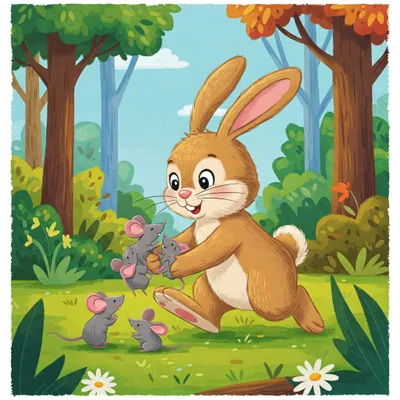Little Bunny Foo Foo

Lyrics
Hopping through the forest,
Scooping up the field mice,
And bopping them on the head.
(Spoken slowly: Boink!)
Down came the Good Fairy, and she said:
"Little Bunny Foo Foo,
I don't want to see you,
Scooping up the field mice,
And bopping them on the head.
I'll give you three chances,
And if you don't behave,
I'm gonna turn you into a GOON!"
(Repeat the first verse)
Down came the Good Fairy, and she said:
"Little Bunny Foo Foo,
I don't want to see you,
Scooping up the field mice,
And bopping them on the head.
I'll give you two more chances,
And if you don't behave,
I'm gonna turn you into a GOON!"
(Repeat the first verse)
Down came the Good Fairy, and she said:
"Little Bunny Foo Foo,
I don't want to see you,
Scooping up the field mice,
And bopping them on the head.
I'll give you one more chance,
And if you don't behave,
I'm gonna turn you into a GOON!"
(Repeat the first verse)
Down came the Good Fairy, and she said:
"Little Bunny Foo Foo,
I gave you three chances,
And you didn't behave,
So now I'm gonna turn you into a GOON!"
(Magical sound effect: Poof!)
(Spoken:) "And the moral of the story is: Hare today, Goon tomorrow."
History and Meaning
Unlike many traditional folk rhymes with centuries-old roots, "Little Bunny Foo Foo" is distinctly modern, emerging as a children's poem and song likely in the mid-to-late 20th century within the United States. The earliest documented references place its existence around 1970, with Beverly Cleary's children's novel "Runaway Ralph" mentioning a character hearing a song called "Little Rabbit Fru-Fru" at summer camp, and a January 1970 issue of The New Yorker referring to "Little Bunny Phoo Phoo." These early mentions suggest the rhyme was primarily transmitted through informal childlore, particularly in settings like summer camps. The melody used for singing the verses is borrowed from the much older French-Canadian children's song "Alouette" (1879), a tune also melodically similar to "Down by the Station" and "Itsy Bitsy Spider."
The narrative follows a simple, repetitive structure: the titular bunny hops through the forest, repeatedly "scooping up the field mice / And bopping them on the head." An authority figure, the Good Fairy, intervenes, warning the bunny that it has three chances to cease this behavior or face transformation into a "goon." The verses repeat, documenting the bunny ignoring these warnings and losing chances one by one, until the final verse where the Fairy enacts the threatened punishment. Performance typically involves hand gestures mimicking the actions of scooping and bopping, enhancing its participatory nature for children. The structure alternates between sung verses describing the bunny's actions and spoken lines delivered as the Good Fairy's dialogue, making the story easy for young children to follow through its repetitive pattern.
Most commonly, "Little Bunny Foo Foo" is interpreted as a straightforward cautionary tale about behavior, consequences, and the misuse of power, particularly addressing bullying. The moral message is that aggressive actions directed toward those smaller or weaker (the field mice) will not be tolerated and will result in punishment administered by a moral authority (the Good Fairy). The consequence itself—being turned into a "goon"—remains somewhat ambiguous. Different interpretations suggest it might mean becoming a bully or thug, a simpleton, or a troll-like figure, while many believe the term primarily serves the concluding pun: "Hare today, goon tomorrow." This type of story culminating in a pun is known as a feghoot, and the somewhat vague nature of the punishment reflects the rhyme's origins in informal childlore, where playful language and rhythm often take precedence over narrative consistency.
Like many folk rhymes, "Little Bunny Foo Foo" exists in several variations despite its relatively recent creation. One significant alternative replaces "bopping" the mice with "kissing" them, shifting the moral implications from violence to perhaps unwanted affection or simply repetitive, annoying behavior. Other narrative variations include the bunny moving from bopping mice to bopping other animals after being warned, suggesting a lesson about specific instructions. Cori Doerrfeld's picture book "Little Bunny Foo Foo: The Real Story" offers a revisionist take where the mice had stolen the bunny's desserts, providing justification for the bopping and questioning the Fairy's judgment. The rhyme has permeated popular culture, referenced by indie band The Moldy Peaches, in My Little Pony materials, children's shows like Barney and Sesame Street, and even South Park. A large statue named "Bunny Foo Foo" stands at a California winery, demonstrating how even modern folklore continues to be adapted and reinterpreted across various media and contexts.